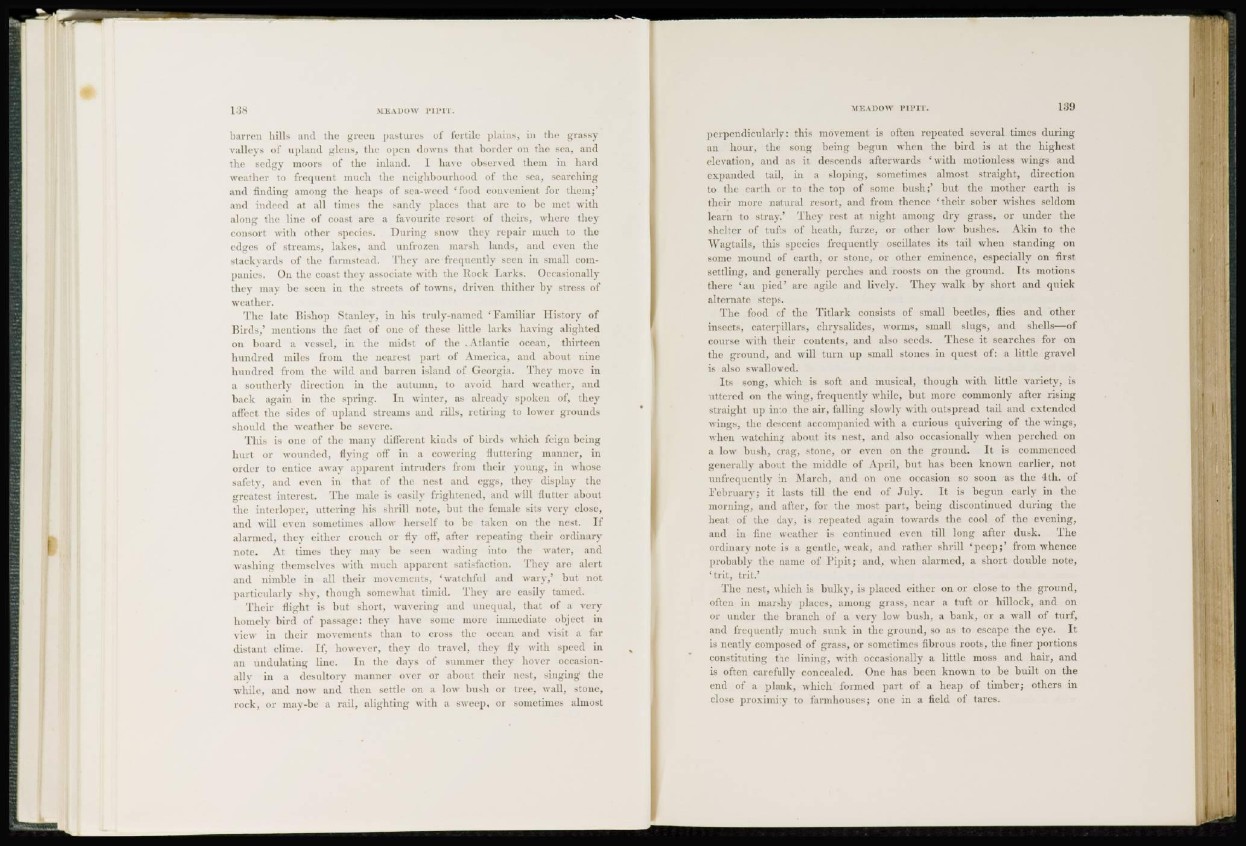
138 ME U)OW I'll'l 1.
barren hills and the green pastures of fertile plains, in the grassy
valleys of upland glens, the open downs that border on the sea, and
the sedgy moors of the inland. I have observed them in hard
weather to frequent much the neighbourhood of the sea, searching
and finding among the heaps of ^ea-weed 'food convenient for them;'
and indeed a! all times the sandy places that are to be met with
along the line of coast are a favourite resort of theirs, where they
consort with other species. During snow they repair much to the
edges of streams, lakes, and unfrozen marsh lands, and even the
stackyards of the farmstead. They are frequently seen in small companies
On the coast they associate with the Rock Larks. Occasionally
they ina\ be seen in the streets of towns, driven thither by stress of
weather.
The late Bishop Stanley, in his truly-named 'Familiar History of
Birds,' mentions the fact of one of these little larks having alighted
on board a vessel, in the midst of the . Atlantic ocean, thirteen
hundred miles from the nearest pari of America, and about nine
hundred from the wild and barren island of Georgia. They move in
a southerly direction in the autumn, to avoid hard weather, and
back again in the spring. In winter, as already spoken of, they
affect the sides of upland streams and rills, retiring to lower grounds
should the weather be severe.
This is one of the many different kinds of birds which feign being
hint or wounded, flying off in a cowering fluttering manner, in
order t o entice away apparent intruders from their young, in whose
safety, and even in that of the nest and eggs, they display the
greatest interest. The male is easily frightened, and will flutter about
the interloper, uttering his shrill note, but the female sits very close,
and will even sometimes allow herself to be taken on the nest. If
alarmed, they either crouch or fly off, alter repeating their ordinary
note. At times they ma\ he seen wading into the water, and
washing themsehes with much apparent satisfaction. They are alert
and nimble in all their movements, 'watchful and wary,* but not
particularly shy, though somewhat timid. They arc easily tamed.
Their flight is but short, wavering and unequal, that of a very
homeh bird o f passage: they have some more immediate object in
view in iheir movements than to cross the ocean and visit a far
distanl clime. If, howei er, they do tra\ el. they fly w ilh speed in
an undulating line. In the days of summer they hover occasionally
in a desultory manner over or about their nest, singing the
while, and now and then settle on a low bush or tree, wall, stone,
rock, or mav-bc a rail, alighting with a sweep, or sometimes almost
MEADOW PIPIT. 139
perpendicularly: this movement is often repealed several times during
an hour, the song being begun when the bird is at the highest
elevation, and as it descends afterwards ' with motionless wings and
expanded tail, in a sloping, sometimes almost straight, direction
to the earth or to the top of some bush;' but the mother earth is
their more natural resort, and from thence 'their sober wishes seldom
learn to stray.' They rest at night among dry grass, or under tin1
shelter of tufts of heath, furze, or other low bushes. Akin to the
Wagtails, this species frequently oscillates its tail whim standing on
some mound of earth, or stone, or other eminence, especially on first
settling, and generally perches and roosts on the ground. Its motions
there (au pied' are agile and lively. They walk by short and quick
alternate steps.
The food of the Titlark consists of small beetles, flies and other
insects, caterpillars, chrysalides, worms, small slugs, and shells—of
course with their contents, and also seeds. These it searches for on
the ground, and will turn up smaU stones in quest of: a little gravel
is also swallowed.
Its song, which is soft and musical, though with little variety, is
uttered on the wing, frequently while, but more commonly after rising
straighl up into the air, falling slowly with outspread tail and extended
^ings, the descent accompanied with a curious quivering of the wings,
when watching about its nest, and also occasionally when perched on
a low bush, crag, stone, or even on the ground. It is commenced
generally about the middle of April, hut has been known earlier, not
{infrequently in March, and on one occasion so soon as the 4th. of
February; it lasts till the end of July. It is begun early in the
morning, and after, for the most part, being discontinued during the
heal el' the day, is repeated again towards the cool of the evening,
and in line weather is continued even till long after dusk. The
ordinary note is a gentle, weak, and rather shrill 'peep;' from whence
probably the name of Pipit; and, when alarmed, a short double note,
'trit, trit.'
The nest, which is bulky, is placed either on or close to the ground,
oiten in marshy places, among grass, near a tuft or hillock, and on
or under the branch of a very low bush, a bank, or a wall of turf,
and frequently much sunk in the ground, so as to escape the eye. It
is neatly composed of grass, or sometimes fibrous roots, the finer portions
constituting the lining, with occasionally a little moss and hair, and
is often carefnllv concealed. One has been known to be built on the
end of a plank, which formed part of a heap of timber; others in
close proximity to farmhouses; one in a field of tares.